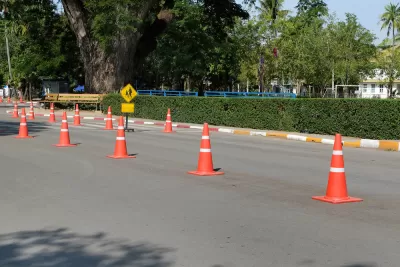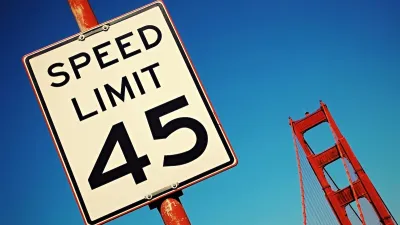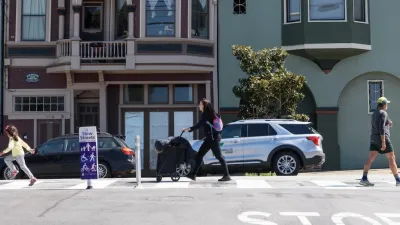The San Francisco Transformation Agency is tired of watching cyclists and pedestrians die while the city promises more Vision Zero improvements.

A group of safety activists came together to implement a DIY safety improvement project at Sixth and Mission in San Francisco "after the deaths of two bicyclists, Heather Miller and Kate Slattery, who were killed the evening of June 22 after being struck by hit-and-run motorists," according to Bryan Goebel.
The action involved placing cones along the street to create a bump-out at a notoriously busy intersection, where pedestrian infrastructure is deteriorating and often ignored by drivers.
The so-called San Francisco Transformation Agency, or SFMTrA, takes inspiration from "similar guerrilla actions in Seattle, Portland and New York," writes Goebel, in moving beyond the Vision Zero efforts of the city. "They point out that despite the city’s Vision Zero effort, which has a goal of ending all traffic deaths by 2024, 26 people have died in traffic collisions so far in 2016," adds Goebel.
In related news at the national level, Angie Schmitt reports that the National Transportation Safety Board (NTSB), usually tasked with investigating train crashes and plane crashes, has finally taken an interest in cycling fatalities. The Systematic Failure blog first noted that NTSB would investigate the fatal crash that killed five people in Kalamazoo, Michigan. Schmitt adds the extra commentary that the NTSB is still missing a larger part of the point:
Some good might come out of this investigation, but how representative is this crash of the 700+ cyclist deaths in the U.S. each year? If the NTSB wants to make a difference for bicycling safety, it should examine the systemic causes of cycling fatalities.
FULL STORY: Spurred by S.F. Cyclist Deaths, Guerrilla Safe Streets Activists Take Action

Manufactured Crisis: Losing the Nation’s Largest Source of Unsubsidized Affordable Housing
Manufactured housing communities have long been an affordable housing option for millions of people living in the U.S., but that affordability is disappearing rapidly. How did we get here?

Americans May Be Stuck — But Why?
Americans are moving a lot less than they once did, and that is a problem. While Yoni Applebaum, in his highly-publicized article Stuck, gets the reasons badly wrong, it's still important to ask: why are we moving so much less than before?

Using Old Oil and Gas Wells for Green Energy Storage
Penn State researchers have found that repurposing abandoned oil and gas wells for geothermal-assisted compressed-air energy storage can boost efficiency, reduce environmental risks, and support clean energy and job transitions.

Greening Oakland’s School Grounds
With help from community partners like the Trust for Public Land, Oakland Unified School District is turning barren, asphalt-covered schoolyards into vibrant, green spaces that support outdoor learning, play, and student well-being.

California Governor Suspends CEQA Reviews for Utilities in Fire Areas
Utility restoration efforts in areas affected by the January wildfires in Los Angeles will be exempt from environmental regulations to speed up the rebuilding of essential infrastructure.

Native American Communities Prepare to Lead on Environmental Stewardship
In the face of federal threats to public lands and conservation efforts, indigenous groups continue to model nature-centered conservation efforts.
Urban Design for Planners 1: Software Tools
This six-course series explores essential urban design concepts using open source software and equips planners with the tools they need to participate fully in the urban design process.
Planning for Universal Design
Learn the tools for implementing Universal Design in planning regulations.
Heyer Gruel & Associates PA
City of Moreno Valley
Institute for Housing and Urban Development Studies (IHS)
City of Grandview
Harvard GSD Executive Education
Salt Lake City
NYU Wagner Graduate School of Public Service
City of Cambridge, Maryland





























